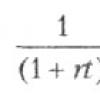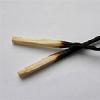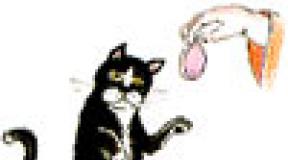Relay races in nature. Games and competitions in nature for children and adults
These competitions will help teachers and parents entertain their children. They can be carried out in classes, festive events, at home, on the street.
Firefighters
Turn out the sleeves of two jackets and hang them on the backs of chairs. Place the chairs at a distance of one meter with their backs facing each other. Place a two-meter long rope under the chairs. Both participants stand at their chairs. At a signal, they must take their jackets, turn out the sleeves, put them on, and fasten all the buttons. Then run around your opponent’s chair, sit on your chair and pull the string.
Who is faster
Children with skipping ropes in their hands stand in a line on one side of the playground so as not to interfere with each other. In 15 - 20 steps, a line is drawn or a cord with flags is laid down. Following the agreed signal, all children simultaneously jump in the direction of the placed cord. The one who gets near her first wins.
Hitting the ball on target
A pin or flag is placed at a distance of 8-10 m. Each team member gets the right to one throw, he must try to knock down the target. After each throw, the ball is returned to the team. If the target is shot down, it is replaced in its original place. The team with the most accurate hits wins.
- the ball does not fly, but rolls along the ground, launched by hand,
- players kick the ball,
- players throw the ball with both hands from behind their heads.
Ball in the ring
Teams are lined up in a single column, one at a time, in front of the basketball backboards at a distance of 2–3 meters. After the signal, the first number throws the ball around the ring, then puts the ball, and the second player also takes the ball and throws it into the ring, and so on. The team that hits the hoop the most wins.
Artists
In the center of the circle or stage are two easels with paper. The leader calls two groups of five people. At the signal from the leader, the first from the group take the coal and draw the beginning of the picture; at the signal, they pass the coal to the next one. The task is for all five competitors to draw a given drawing faster than their opponents. Everyone must participate in drawing.
The tasks are simple: draw a steam locomotive, a bicycle, a steamship, a truck, a tram, an airplane, etc.
Roll a ball
The players are divided into groups of 2 - 5 people. Each of them receives a task: within a set time (8 - 10 minutes) roll a snowball as large as possible. The group that rolls the largest snowball by the specified time wins.
Three ball run
At the starting line, the first person conveniently takes 3 balls (football, volleyball and basketball). At the signal, he runs with them to the turning flag and places the balls near it. It comes back empty. The next participant runs empty to the lying balls, picks them up, returns with them back to the team and, not reaching 1 m, places them on the floor.
- instead of large balls, you can take 6 tennis balls,
— instead of running, jumping.
Chain
In the allotted time, make a chain using paper clips. Whose chain is longer wins the competition.
Blow up the balloon
For this competition you will need 8 balloons. 8 people are selected from the audience. They are given Balloons. At the leader’s command, the participants begin to inflate the balloons, but in such a way that the balloon does not burst when inflated. The one who completes the task first wins.
turnip
Two teams of 6 children each participate. This is grandfather, grandmother, Bug, granddaughter, cat and mouse. There are 2 chairs on the opposite wall of the hall. On each chair sits a turnip - a child wearing a hat with a picture of a turnip.
Grandfather starts the game. At a signal, he runs to the turnip, runs around it and returns, the grandmother clings to him (takes him by the waist), and they continue running together, again go around the turnip and run back, then the granddaughter joins them, etc. At the end of the game, The mouse is caught by a turnip. The team that pulled out the turnip the fastest wins.
Hoop relay
Two lines are drawn on the track at a distance of 20 - 25 m from one another. Each player must roll the hoop from the first to the second line, go back and pass the hoop to his friend. The team that completes the relay first wins.
Counter relay race with hoop and skipping rope
Teams line up as if in a relay race. The guide of the first subgroup has a gymnastic hoop, and the guide of the second subgroup has a jump rope. At the signal, the player with the hoop rushes forward, jumping through the hoop (like jumping rope). As soon as the player with the hoop crosses the starting line of the opposite column, the player with the jump rope starts and moves forward by jumping the rope. After completing the task, each participant passes the equipment to the next player in the column. This continues until the participants complete the task and change places in the columns. Jogging is prohibited.
Porters
4 players (2 from each team) stand on the starting line. Everyone gets 3 large balls. They must be carried to the final destination and returned back. It is very difficult to hold 3 balls in your hands, and picking up a fallen ball without outside help is also not easy. Therefore, porters have to move slowly and carefully (the distance should not be too great). The team that completes the task faster wins.
Ball race underfoot
Players are divided into 2 teams. The first player throws the ball back between the players' spread legs. The last player of each team bends down, catches the ball and runs forward with it along the column, stands at the beginning of the column and again sends the ball between his spread legs, etc. The team that finishes the relay the fastest wins.
Three jumps
Participants are divided into two teams. Place a jump rope and a hoop at a distance of 8-10 m from the starting line. After the signal, the first person, having reached the rope, takes it in his hands, makes three jumps on the spot, puts it down and runs back. The second person takes the hoop and makes three jumps through it and alternates between the jump rope and the hoop. The team that finishes it faster will win.
Hoop race
The players are divided into equal teams and lined up along the side lines of the court. On the right flank of each team there is a captain; he is wearing 10 gymnastic hoops. At the signal, the captain takes off the first hoop and passes it through himself from top to bottom, or vice versa and passes it to the next player. At the same time, the captain takes off the second hoop and passes it to his neighbor, who, having completed the task, passes the hoop on. Thus, each player, having passed the hoop to his neighbor, immediately receives a new hoop. The last player in the line puts all the hoops on himself. The team whose players complete the task faster receives a winning point. The team whose players win twice wins.
Quick threes
Players stand in a circle in threes, one after the other. The first numbers of each three join hands and form an inner circle. The second and third numbers, holding hands, form a large outer circle. At the signal, the guys standing in the inner circle run to the right with side steps, and those standing in the outer circle run to the left. At the second signal, the players release their hands and stand in their threes. Each time the circles move in a different direction. The three players who come together faster receive a winning point. The game lasts 4 - 5 minutes. The trio whose players score the most points wins.
Prohibited movement
The players and the leader stand in a circle. The leader takes a step forward to be more noticeable. If there are few players, then you can line them up and stand in front of them. The leader invites the children to perform all the movements after him, with the exception of those prohibited, which were previously established by him. For example, it is prohibited to perform the “hands on the belt” movement. The leader begins to make different movements to the music, and all the players repeat them. Unexpectedly, the leader performs a prohibited movement. The player repeating it takes a step forward and then continues to play.
Courtesy check
This competition is tricky and is only held once. Before the start of the boys' competition, a girl passes in front of them and, as if by accident, drops her handkerchief. The boy who guessed to pick up the scarf and politely return it to the girl wins. After this it is announced that this was the first competition.
Option: if the competition is between two teams, then the point is awarded to the one from which the most polite boy was.
Good fairy tale
The basis is a fairy tale with a sad ending (for example, the Snow Maiden, the Little Mermaid, etc.). And the children are given the task of thinking about how this fairy tale can be remade, using characters from other fairy tales, so that it ends happily. The winner is the team that plays out the fairy tale in the form of a mini-play in the most funny and cheerful way.
Train
The game participants are divided into two equal groups. The players of each group hold on to each other and form one chain with their arms bent at the elbows.
Stronger and more dexterous participants – “groovy” ones – become ahead of the chain. Standing opposite each other, the “clockwork” also takes each other’s arms bent at the elbows and each pulls in their own direction, trying to either break the opponent’s chain or pull it over the intended line.
Rule: start pulling exactly at the signal.
Story competition folk tales
Children are divided into two teams. The presenter says the first words from the title of folk tales; participants must say the entire title. The team that gives the most correct answers wins.
1. Ivan Tsarevich and the gray... (wolf)
2. Sister Alyonushka and brother... (Ivan)
3. Finist - Clear... (falcon)
4. Princess - ... (Toad)
5. Geese - ... (Swans)
6. By pike... (order)
7. Moroz... (Ivanovich)
8. Snow White and the seven... (dwarfs)
9. Horse - ... (Humpbacked Little Humpback)
Speak without mistakes
Whoever pronounces these proverbs better will win:
Sasha walked along the highway and sucked on a dryer.
Karl stole corals from Clara, and Clara stole a clarinet from Karl.
The ships tacked and tacked, but did not tack.
He reported, but didn’t report enough, but when he began to report more, he reported.
Night travel
The presenter says that the driver will have to drive at night without lighting, so the player is blindfolded. But first, the driver is introduced to a freeway made from sports pins. Handing the steering wheel to the driver, the presenter offers to practice and drive so that not a single post is knocked down. The player is then blindfolded and brought to the steering wheel. The presenter gives a command - a hint where to turn to the driver, warns about danger. When the path has been completed, the leader unties the driver's eyes. Then the next participants in the game “go”. The one who knocks down the pins the least wins.
Sharp shooters
There is a target mounted on the wall. You can use small balls or darts.
Each player has three tries.
After the game, the host rewards the winners and encourages the losers.
Keep your balance
With their arms extended to the sides, the players, like tightrope walkers, walk along the very edge of the carpet.
The last one to leave the race wins.
Horror
The conditions are as follows: there are five eggs in the cassette. One of them is raw, the presenter warns. And the rest are boiled. You need to break an egg on your forehead. Whoever comes across something raw is the bravest one. (But in general, the eggs are all boiled, and the prize is simply awarded to the last participant - he deliberately took the risk of becoming everyone’s laughing stock.)
Game "Merry Orchestra"
An unlimited number of people participate in the game. A conductor is selected, the remaining participants are divided into balalaika players, accordionists, trumpeters, violinists, etc., depending on the number of participants. At a signal from the conductor, who points to a group of musicians, they begin to “play” to the tune of any famous song: balalaika players - “Trem, shake”, violinists - “tili-tili”, trumpeters - “turu-ru”, accordionists - “tra- la-la." The difficulty of the task is that the pace of change of musicians is constantly increasing, the conductor points first to one group, then to the other, and if the conductor waves both hands, then the musicians must “play” all together. You can make the task more difficult: if the conductor waves his hand strongly, then the musicians must “play” loudly, and if he waves his hand a little, then the musicians “play” quietly.
Game "Collect a bouquet"
2 teams of 8 people each participate. 1 child in the team is a gardener, the rest are flowers. On the heads of the flower children are hats with images of flowers. Flower children squat in a column, one at a time, at a considerable distance from each other. At a signal, the gardeners run to the first flower, which grabs the gardener’s back. Already the two of them are running to to the next flower etc. The team that reaches the finish line first wins.
ring
You will need a long cord and a ring. Thread the cord through the ring and tie the ends. Children sit in a circle and place a cord with a ring on their knees. In the center of the circle is the driver. Children, unnoticed by the driver, move the ring from one to another (not necessarily in one direction, you can move the ring in different directions). At the same time, music sounds, and the driver carefully monitors the movements of the ring. As soon as the music stops, the ring also stops. The driver must indicate who currently has the ring. If you guess right, you change places with the one who had the ring.
And I!
A game of attentiveness.
Rules of the game: the presenter tells a story about himself, preferably a fable. During the story, he pauses and raises his hand up. The rest should listen carefully and, when the leader raises his hand up, shout “and I” if the action mentioned in the story can be performed by a person or remain silent if the action is not suitable. For example, the presenter says:
“One day I went into the forest...
All: “Me too!”
I see a squirrel sitting on a tree...
-…?
The squirrel sits and gnaws nuts...
— ….
- She saw me and let’s throw nuts at me...
-…?
- I ran away from her...
-…?
- I went the other way...
— ….
- I’m walking through the forest, picking flowers...
— …
- I sing songs...
— ….
— I see a little goat nibbling the grass... -...? - As soon as I whistle...
— ….
— The little goat got scared and ran away...
-…?
- And I moved on...
— …
There are no winners in this game - the main thing is a cheerful mood.
Repeat
Children stand in one line. By lot or counting, I choose the first participant. He faces everyone and performs some movement, for example: clapping his hands, jumping on one leg, turning his head, raising his arms, etc. Then he stands in his place, and the next player takes his place. He repeats the movement of the first participant and adds his own.
The third player repeats the two previous gestures and adds his own, and so do the rest of the game participants in turn. When the whole team has finished showing, the game can go on for the second round. A player who fails to repeat any gesture is eliminated from the game. The winner is the last child standing.
Sparrows and crows
You can play together with a child, but better company. Agree in advance what the sparrows will do and what the crows will do. For example, with the command “Sparrows,” children will lie down on the floor. And when the Crows command, climb onto the bench. Now you can start the game. An adult slowly pronounces, syllable by syllable, “Vo - ro - ... ny!” Children must quickly perform the movement that was assigned to the crows. Whoever completed it last or got it wrong pays a forfeit.
Plucking feathers
You will need clothespins. Several children will be catchers. They are given clothespins, which they attach to their clothes. If the catcher catches one of the children, he attaches a clothespin to his clothes. The first catcher to free himself from his clothespins wins.
Looking for the ball
The participants of the game stand in a circle and close their eyes. The leader takes a small ball or any other small object and throws it further to the side. Everyone listens carefully, trying to guess by the sound where the ball fell. At the command “Look!” children run in different directions, looking for the ball. The winner is the one who finds it, quietly runs up to a pre-agreed place and knocks with a stick with the words “The ball is mine!” If other players guess who has the ball, they try to catch up with him and grab him. Then the ball goes to the player who caught up. Now he is running away from the others.
Glomerulus
Children are divided into pairs. Each pair is given a ball of thread and a thick pencil. At the leader’s signal, the children begin to rewind the ball onto a pencil. One of the children holds the ball, the second winds the thread around the pencil. The pair that completes the job the fastest wins. A second prize can be awarded for the neatest ball.
Two rams
This game can be played in pairs taking turns. Two children, with their legs spread wide apart, bend their torsos forward and rest their foreheads against each other. Hands clasped behind back. The task is to confront each other without budging for as long as possible. You can make the sounds “Bee-ee”.
Potato
Invite the children to test their attentiveness, observation and reaction speed. It's very easy to do. Let the guys answer any of your questions: “Potatoes.” Questions can be addressed to everyone, and sometimes it is better to ask one. For example: “What do you have in this place?” (pointing to his nose).
The reaction is not hard to imagine. Whoever makes a mistake leaves the game. Do not forget to forgive the most inattentive ones after the first two questions, otherwise you will have no one to continue the game with. Here are some questions you can ask:
— What did you have for lunch today?
-What would you like to eat for dinner?
- Who is this who is late and is entering the hall now?
— What did your mother bring you as a gift?
-What do you dream about at night?
— What is the name of your favorite dog? … and so on.
At the end of the game, give the winners - the most attentive guys - a comic prize - a potato.
Truckers
Plastic cups or small buckets of water filled to the brim are placed on children's trucks. Ropes of the same length (according to the child’s height) are tied to the cars. On command, you must quickly “carry the load” from start to finish, trying not to spill the water. The winner is the one who reaches the finish line the fastest and does not spill the water. You can make two prizes - for speed and for accuracy.
Crumple up the newspaper
You will need newspapers according to the number of participants. There is an unfolded newspaper on the floor in front of the players. The task is to crumple the newspaper at the presenter’s signal, trying to collect the entire sheet into a fist.
Whoever can do this first is the winner.
Clever janitor
To play, you need to prepare a broom and “leaves” (You can use small pieces of paper). A circle is drawn - this is the place of the “janitor.” The janitor is selected. The “janitor” stands in a circle with a broom. At the leader’s signal, the rest of the participants pretend to be the “wind,” that is, they throw pieces of paper into the circle, and the “janitor” sweeps out the trash. The “janitor” is considered the winner if after the agreed time (1-2 minutes) there is not a single piece of paper in the circle.
Self-portrait
Two slits for hands are made on a sheet of whatman paper or cardboard. Participants take each sheet of paper, insert their hands into the slots, and draw a portrait with a brush without looking. Whoever has the most successful “masterpiece” takes the prize.
"Monkey"
Children are divided into two teams. After which the players of the first team confer and think of a word for one of the players of the second team. His task is to show this word to his team members only with gestures, without using any sounds or words. When the word is guessed, the teams change places.
Depending on the age of the participants, the complexity of the hidden words may vary. Beginning with simple words and concepts, such as “car”, “house”, and ending with complex concepts, names of films, cartoons, books.
Snowflake
Each child is given a “snowflake”, i.e. a small ball of cotton wool. Children loosen their snowflakes and, at your signal, launch them into the air and begin to blow on them from below so that they stay in the air as long as possible. The most dexterous one wins.
Land - water
Participants of the competition stand in one line. When the leader says “land,” everyone jumps forward; when they say “water,” everyone jumps back. The competition is held at a fast pace. The presenter has the right to pronounce other words instead of the word “water,” for example: sea, river, bay, ocean; instead of the word “land” - shore, land, island. Those who jump at random are eliminated, the winner is the last player - the most attentive.
Drawing a portrait
Participants try to draw a portrait of any of those sitting opposite. Then the leaves are sent in a circle. Everyone on back side will try to write who he recognized in this portrait. When the leaves go around the circle and return to the author, he will count the number of votes of the participants who recognized the one drawn. The best artist wins.
Lock
Players are given a bunch of keys, closed the padlock. It is necessary to pick up the key from the bunch and open the lock as quickly as possible. You can put a lock on the cabinet where the prize is hidden.
Sniper
All players close their eyes and pull matches from the pile one at a time. You cannot show your match to your neighbor. One of the matches is broken, and the one who takes it out becomes a sniper. Then everyone opens their eyes and the day begins. A sniper can kill a player by looking into his eyes and winking. The “killed” person leaves the game and loses the right to vote.
If one of the players witnesses a “murder”, he has the right to say loudly about it, at this moment the game stops (that is, the sniper cannot kill anyone), and the players find out if there are any more witnesses. If not, the game continues, and if there is, the angry players lynch the suspect, taking the match away from him and thus finding out whether they made a mistake. The sniper's task is to shoot everyone before he is exposed, the task of everyone else is to expose the sniper before he shoots everyone.
Chinese football
The players stand in a circle facing outward, with their feet shoulder-width apart, so that each foot stands close to the symmetrical leg of its neighbor. Inside the circle there is a ball, which the players try to score into each other’s goal (that is, roll the ball between their legs with their hands). The one between whose legs the ball rolls removes one hand, after the second goal - the second, and after the third - leaves the game.
Aram-shim-shim
The players stand in a circle, alternating by gender (that is, boy-girl-boy-girl, and so on), with the driver in the center. The players rhythmically clap their hands and say the following words in chorus: “Aram-shim-shim, aram-shim-shim, Arameya-Zufiya, point to me!” And again! And two! And three!”, at this time the driver, closing his eyes and pointing his hands forward, rotates in place, and when the text ends, he stops and opens his eyes. The representative of the opposite sex closest in the direction of rotation to the place shown to them also goes to the center, where they stand back to back. Then everyone else claps their hands again, saying in unison: “And once! And two! And three!". On the count of three, those standing in the center turn their heads to the sides. If they looked in different directions, then the driver kisses (usually on the cheek) the one who came out, if in one direction, they shake hands. After which the driver stands in a circle, and the one who leaves becomes the driver.
There is also a version of the game in which for the representatives of the stronger sex spinning in the center the words “Aram-shim-shim, ...” are replaced with “Wider, wider, wider circle! He has seven hundred girlfriends! This one, this one, this one, this one, and my favorite one is this one!”, although in general it doesn’t matter.
While playing the game younger age, it makes sense to replace kisses with scary faces that the two in the center make at each other.
And I'm going
The players stand in a circle facing inward. One of the seats remains free. The one standing to the right of the free space says loudly, “And I’m coming!” and goes over to him. The next one (that is, the one who is now standing to the right of the empty seat) loudly says “Me too!” and moves on to him, the next one says “And I’m a hare!” and also takes place on the right. The next one, moving on, says “And I’m with...” and names someone from those standing in the circle. The task of the one who was named is to run to an empty place. In this game, you can add a driver who will wedge into an empty seat when someone is thinking too long.
Game "Lanterns"
This game involves 2 teams. Each team has 3 yellow balls. At the command of the presenter, the audience begins to pass the balls from hand to hand from the first row to the last. You need to pass the balls (fire) with your hands raised and return them back in the same way, without extinguishing the fire (i.e. without bursting the ball).
Competition "Who can collect coins faster"
The competition is open to 2 people (more is possible). Game coins made of thick paper are scattered around the site. The participants' task is to collect money blindfolded. The one who collects the most coins the fastest wins. This competition can be repeated 2 - 3 times.
Rain
The players are free to sit in the room. When the text begins, everyone performs voluntary movements. WITH the last word“stopped” all movements stop, the participants in the game seem to freeze. The presenter, passing by them, notices the one who moved. He leaves the game. A wide variety of movements can be used, but always while standing still. At the end of the game, the presenter also marks those who performed the most beautiful or complex movements.
Text:
Rain, rain, drop,
Water Saber,
I cut a puddle, I cut a puddle,
Cut, cut, didn't cut
And he got tired and stopped!
Surprise
A rope is stretched across the room, to which the
various small prizes. The children are blindfolded one by one and given
scissors and they cut off their prize with their eyes closed. (Be
Be careful, do not leave children alone while playing this game!).
Cockroach race
For this game you will need 4 matchboxes and 2 threads (for two participants). The thread is tied to the belt in front, and a matchbox is tied to the other end of the thread so that it hangs between the legs. The second box is placed on the floor. Swinging boxes between their legs like a pendulum, participants must push boxes lying on the floor. Whoever covers the pre-determined distance faster is considered the winner.
Fishing
A deep plate is placed on a chair, participants must take turns throwing a button or a bottle cap into it from a distance of 2-3 meters, trying to hit it so that the button remains in the plate.
This simple game It really captivates and captivates the kids.
Watchman
The guys sit on chairs so that a circle is formed. There must be a player behind each person sitting on a chair, and one chair must be free. The player standing behind him must discreetly wink at any of those sitting in the circle. All seated participants must face the player with an empty chair. A sitting participant, seeing that he has been winked at, must quickly take an empty seat. The functions of the players standing behind those sitting are to prevent their players from going to empty seats. To do this, they just have to put their hand on the shoulder of the person sitting. If the “guard” does not release the “fugitive”, they change places.
One - knee, two - knee
Everyone sits down on chairs again in a tight circle. Then everyone should put their hand on right knee neighbor on the left. Did you put it in? So, now, starting with the counselor, a light hand clap should pass clockwise across all knees in turn. At first - right hand counselor, then left hand his neighbor on the right, then the right hand of the neighbor on the left, then the left hand of the counselor, etc.
The first round is held so that the guys understand how to act. After this the game begins. The one who made a mistake during the game removes the hand that either delayed its clap or made it earlier. If a player removes both hands, he leaves the circle and the game continues. To complicate the task, the counselor gives the count faster and faster, under which the clap should be made. The last three players standing win. and receive a certificate for certification?
This relay race can be carried out outdoors, when it is already warm. Since the relay race is held on fresh air, then the competitions will be on the theme of nature. Team names, mottos and emblems can be associated with plants, birds and animals.
This is a family relay race. All participants must be divided into two teams so that there are equal numbers of parents and children.
Warm-up
Children guess, parents help in case of difficulty.
“He sleeps during the day, flies at night and scares passers-by.” (Owl)
"The brothers stood on stilts,
looking for food along the way.
Whether I'm running or walking,
They won’t get off their stilts.” (Herons)
“I grow from the earth, I clothe the whole world.” (Linen)
"White peas on a green stem." (Lily of the valley)
"It cheers in the spring, cools in the summer, nourishes in the fall, warms in the winter." (Forest)
"The beast is afraid of my branches,
the bird will not build nests in them.
My beauty and power are in the branches.
Tell me quickly, who am I?" (Deer)
"In a dense forest under the fir trees,
covered with leaves,
lies a ball of needles,
prickly and alive." (Hedgehog)
"An oak tree hid in a golden ball." (Acorn)
"Sisters stand in the meadows - golden eyes, white eyelashes." (Daisies)
For each riddle guessed, the team receives a point.
Getting ready for the hike
The team is given a backpack (it can be replaced with any bag), a set of dishes (cup, mug, spoon, flask) and matches. If there are many people in the team, then you can take two sets of dishes.
The team lines up, with a backpack in front of the first participant. There are dishes 15-20 steps away from both teams. Each player needs to run to the dishes, take one item, return, put it in the backpack and touch the next player with his hand - “pass” the baton. Then the next participant runs.
Teams are given three points for speed and for neatly packing their backpack.
Orientation
Two circles are drawn on the ground, in which the team players take turns standing (starting from the first pair). In front of them are signs with the cardinal directions (north, south, east, west).
The presenter calls the cardinal direction, both participants must simultaneously turn to the corresponding sign. As soon as one of the pair makes a mistake, a point is given to the team of the second participant, and the following players are called into the circle.
Swamp hummocks
Teams are given two newspapers (“bumps”), and participants again compete in pairs.
At the start, players stand on one newspaper and hold the second one in their hands. The earth acts as a "swamp". You need to run over the “bumps” without getting into the “swamp”. On command, players place a newspaper in front of them, move onto it, take the one they were standing on, place it in front of them, move, etc. A point is awarded to the team whose player reached the finish line faster without stepping on the ground (without falling into the “swamp”). If a player steps past the “bump,” the opposing team automatically gets a point.
Halt
Riddles (children guess, adults help in case of difficulty).
“What animal sleeps upside down all winter?” (Bat)
"Which mother's chicks don't know her?" (Cuckoos)
“Should a bear go into his den with skinny or fat?” (Fat, because fat keeps him warm throughout hibernation)
“Which animals can we say that they go out of their way? (About snakes)
"Where do crayfish spend the winter?" (In burrows near the shore)
"Does a tree grow in winter?" (No)
"Where is the sunflower looking?" (In the sun)
"Why can't you touch the eggs in a bird's nest?" (Because then the bird will abandon the nest)
“Which tree leaves turn red in autumn?” (Rowan, aspen, maple)
“Which birds have a “nursery”? (Penguins. The chicks cuddle together and keep warm. There are up to a thousand penguins in such creches.)
For each guessed riddle, the team gets a point.
Chef competition
Take water from a cup into a spoon, carry it to the next cup without spilling it, then return and “pass” the baton to the next participant. The receiver, before running, must come up with and name one animal or bird starting with a given letter, for example:
M (bear, robin, mouse, walrus, etc.) - to the first team.
To (mole, cuckoo, marten, goat, etc.) - to the second team.
Relay race
Jump to the finish line on one leg and come back. The person taking the baton must come up with and name one plant with a specific letter:
K (maple, nettle, bluebell, feather grass, burnet, clover, etc.)
L (lily of the valley, linden, onion, larch, chanterelle, lily, etc.)
The winning team receives five points, the losing team three points.
Merry tree
Ropes of equal length are tied to two trees with trunks approximately equal in thickness. Participants are called in pairs, one from each team. On command, both participants begin to run around the trees and wrap ropes around them. The team whose member is the first to “reel” gets a point.
Running in sacks
Speed relay (can be replaced with jumping to the finish line with tied legs).
Participants jump to the finish line, come back, pass the bag to the next player, etc. The winning team gets three points, the losing team gets one point.
Knock down the pins
Can be used as skittles plastic bottles, into which a little water is poured for stability.
Each team has 3-5 bottles in front of them. You can knock them down with a stick or bottles, or throw them once. Each team gets as many points as they knock down bottles.
Final competition
Children guess, parents help in case of difficulty. Guess which tree the leaf came from. (Prepare the sheet in advance). Guess the plant from the description:
- “The upper side of the leaves of this plant is cold, like a stepmother in a fairy tale, and the lower side is warm, like its own mother.” (Coltsfoot)
- “Today the clearing is golden-yellow from these flowers, and tomorrow it will be white and fluffy.” (Dandelion)
- "They crush him, beat him, soak him, cut him. What is this?" (Linen)
- "Garlands of white bells hang between the wide leaves. And in the summer in their place - red poisonous berry"(Lily of the Valley)
For each correct answer, the team receives one point.
So, we have finished our journey, all that remains is to sum up the results and receive prizes.
Everyone was brave and persistent, and these are the main qualities for any athlete! What about mother laziness? She ran around, became flushed, and became prettier! So maybe we can go to the gym after all? Tomorrow, after work?
Comment on the article "Outdoor Relay Race"
I pre-glued numbers on children's plastic vegetables, guests pulled them out and received souvenirs - children's toys in the Family relay race: how to organize fun outdoor games. Ideas for competitions, examples of mottos and emblem designs.
Poem for a reading competition. Leisure, hobbies. Child from 10 to 13. Raising a child from 10 to 13 years old: education, school problems, relationships with classmates, parents and teachers, additional activities, leisure and hobbies.
New Year's competitions for fifth graders. Leisure, hobbies. Child from 10 to 13. Section: Olympics, competitions (competitions for children 65 rubles). When we studied at a Moscow school, we didn’t know about these competitions, but the teacher (child) moved to the Moscow region...
Discussion
1. "Happy New Year!"
The guys stand in a circle, leading blindfolded, in the middle. Everyone stretches out their hands to the driver, he shakes hands (one) and says: “Happy New Year!” The owner of the hand replies: “And you too!” You can change your voice. If the leader guesses by voice who answered him, then he becomes the leader.
2. Home preparation required.
A hole the size of a child’s face is cut out on a sheet of thick paper (for drawing) in A3 format. A recognizable object is drawn around the hole (snowflake, butterfly, sailor, Doctor Aibolit, fungus, etc.). The driver sits on a chair and looks out the hole, like through a window. Everyone can see who he is, except himself. Using questions Is it living (non-living, animal, can fly, etc.)? must guess who he is.
This competition has been going great for us for three years now. The drawings are sketchy, but easily recognizable.
3. Gemini
Two children take each other by the waist. They have one hand left free. And they have to do something that requires both hands: put a cap on a bottle, cut a circle out of a piece of paper
Yesterday my 5th grader had her New Year's Eve.
Among the competitions were:
1. Drawing the symbol of the year on the board blindfolded (2 people participate at the same time, the winner of the pair is determined by the class)
2. Children stand in a circle and pass the tangerine from hand to hand to the music. The music stops. The one who has the tangerine in his hands sings, dances or recites a poem.
3. Pair competition: Participants are given 2 sheets. You need to walk from one end of the classroom to the other without stepping on the floor. One sheet is placed, the foot is placed on it, then another sheet is placed, the second foot is placed on it, etc.
4. “Sticky”: body parts are written on small pieces of paper (thigh, hand, head, waist, elbow, etc. can be repeated)
Children take turns pulling out pieces of paper and must stick the written parts to the previous participant. It turns out to be a funny caterpillar)
How to celebrate a child's birthday in nature? We offer fun program from our animators! It could be as simple as game program from loved ones fairy-tale heroes, and sports competitions using additional details...
Raising a child from 10 to 13 years old: education, school problems, relationships with classmates, parents and I’m trying to find my daughter (4th grade, almost 11 years old) a poem about winter for a reading competition. The teacher dismissed some of them as very childish or short.
Birthday contests. Toys and games. Child from 7 to 10. Tell me some competitions to entertain children for my son’s birthday. My son is turning 10, there will be no more than 5 boys around the same age, we are celebrating his birthday at the dacha.
Discussion
my favorite is “mummy”, everything is in pairs, each pair has a roll toilet paper, 2 stages - 1) the mummy itself - wrap the partner in paper - who is faster. when everyone finishes - next stage 2nd "the mummy is freed" - the swaddled mummy tears the paper, who is faster and immediately 3rd stage - which pair collects more scraps of paper. For this purpose, each couple was given plastic bowls. The 3rd stage is exclusively for cleanliness, so that garbage does not lie around. It always causes wild delight to first scatter the paper, and then pick it up excitedly. But this year we had to weigh the collected paper - the children demanded accuracy! :). We also play alias and "crocodile", a simplified version - I gave tasks to one person - what to depict with gestures and facial expressions (helicopter, dog, etc.), and the rest guessed.
Discussion
A playground is a place to play for children, not a recreation room for adults. Don’t even hope - read, eat A month before my son’s birthday, I thought that if we take preparations for the celebration more seriously, then perhaps something will work out...
Summer is the time of year when younger and older children spend their days outside. When a group of guys larger than 2-4 people gathers, they want to compete with each other in developing strength, endurance, agility and other skills. Best suited for this fun competitions for children who can spend the summer outside.
Competitions for children in the fresh air in summer
For children spending time outdoors in the summer, the following are best suited:
- "Forest Lapta" At a distance of 10 steps from the children, a predetermined structure of twigs is built. Each participant needs to knock it down with a stick without crossing the drawn line.
- "Fishing". Various small objects are lined up at a predetermined distance from the participants. The first player is given a “fishing rod” - a stick about 2 meters long with a rope tied to it and a weight at its end. The guys’ task is to shoot down targets using a “fishing rod” by swinging the rope.
- "Battle of the Balls" A small rope is tied to the right ankle of each participant with a rope, the length of which does not exceed 30 cm. balloon. In this case, the players hold their hands behind their backs, clasped in a lock. Initially, only 2 children compete with each other, who need to burst the opponent’s balloon with their free foot. The next player joins the one who wins the battle. This continues until one participant remains with a whole projectile.
For children who relax on the beach in the summer, the following competition games are suitable:
- "Teddy Bear." The participant who will portray the bear sits down in the middle of the beach. Around him, all the guys lay out their toys, clothes and other things that can be used for this. At a distance of 5-7 steps from this “composition”, you need to draw a line in the sand with a stick, behind which there will be a safe place, or “house”. At a certain moment, the presenter or one of the guys says “The bear has woken up!”, after which all the players try to save toys and other objects by moving them to the “house”. The bear, in turn, seeks to catch those participants who have nothing in their hands. The one who finds himself in the clutches of the bear replaces him at his post. The competition is won by the player who managed to save the most items and snatch them from the clutches of the predatory beast.
- "Short-legged" Each participant holds an empty plastic bottle between their knees and tries to run away as far as possible. In this case, you need not only to move away, but also to besiege other players so that they return to the beginning of the distance. The child who managed to escape the maximum distance wins.
- "Joust". If there is a wide log on the beach, it can be used as a pedestal for the next competition. Two players must stand on a log and have a duel, trying to stay on it. The one who falls is eliminated from the competition, and the next participant joins the winner.
In the summer, you can also use humorous ones to have fun for children, for example:
- "Fire brigade". The participants of each team stand in a line, and each of them receives 2 disposable cups, one of which is empty and the second is full. A bucket is placed in front of the captain. At the leader’s signal, the last participant pours water into his neighbor’s empty glass, trying not to spill anything. So, gradually, the liquid reaches the captain, who pours it into a bucket. The team that manages to save the most water wins.
- "Ember." Players are divided into 2 teams, and each receives a small pebble. The task of all children is to run to a given place, tossing a pebble as if it were a hot coal, and build a “bonfire” faster than the other team.
 Finally, the following competitions are suitable for children’s quests taking place outside in the summer:
Finally, the following competitions are suitable for children’s quests taking place outside in the summer:
- "Turnip". According to the plot of this competition, grandfather forgot where he sowed the turnip. Moving from one fairy tale character to another, the guys complete simple tasks, for which they receive a piece of the map. From the collected fragments, players need to put together a picture and then find a turnip in a given place.
- "In Search of Lost Treasures." This game is similar to the previous one, but ultimately the guys need to find a chest that was buried by an ancient pirate many years ago.
At the very beginning of the picnic, the leader offers those present natural materials, which they can find in the forest and in the clearing, and create some kind of hero. And closer to the end of the event, a competition is held for the best craft, which is determined by the applause of those present.
Mad Doctor
The game requires a large clearing. One doctor went crazy and started chasing his patients. If he touches a player’s leg, he must jump on one; if he touches his hand, he is prohibited from raising it. Normal doctors can cure sick people; to do this, they must run to the patient and touch him. At the same time, it is important not to fall into the clutches of the enraged one.
Chicken Ryaba
All participants sit in a semicircle, so that the grandfather-driver has his back to them. The contestants have a tennis ball - this is an egg, which all the participants - the "hens" - pass to each other while the music is playing. As soon as the music stops, all the chickens fall onto the grass, including the one with the “egg.” The grandfather turns around and tries to guess which of the “hens” has the testicle. If you guess right, then the hen turns into a grandfather, but if you don’t guess right, the game just continues.
Robinson Crusoe
Participants are divided into pairs and each pair turns into Robinson Crusoe, who must build their own hut (wigwam, whatever, to escape the wind and rain). The guys are given approximately 10-15 minutes, after which, based on the results of voting (applause), they determine the most the best building. And the built huts will become excellent in the future playground for children or the same company will stay overnight in them if the picnic suddenly drags on.
Kisses
This competition is held if a mixed-sex company goes to nature. The presenter goes around everyone present and assigns a letter to the men, and a number to the women. Now a blanket is spread on the grass, the psychic sits there in the lotus position and begins to shape destinies. HE shouts out a combination of letters and numbers, for example Zh9. The girl, who is assigned 9, runs to the screamer and kisses him on the cheek. But the young man who is assigned the letter Z must react even faster and intercept the girl even before the kiss. If he succeeds, then he kisses the lady himself and a “couple” is formed. If he didn’t make it in time, then now the latecomer will have to drive.
gold fish
This competition is ideal for relaxing near the pond. Participants are given a fishing rod; the first one to catch a fish wins a prize. If your vacation takes place far from a pond, then you can use plastic bottles suspended from a tree at a certain height as fish. Couples take part in fishing. One participant climbs onto the second and at the command “start” everyone runs to the tree with the “fish”. Whoever gets to our artificial “pond” faster and catches the fish first wins.
Stone, stick and feather
The game takes place in 2 stages. First stage: find 3 objects (stone, stick and feather) faster than the others. The second stage: “launching” objects - whoever throws a stone the farthest, throws a stick and launches a feather. The fastest, most dexterous and accurate will receive a prize.
Knock it all out
Each participant will need to be timed, so you need to have a timer on your phone. Each participant takes turns hanging a bottle of water from a tree branch on a rope. The participant is blindfolded, spun around and handed a thick stick. At the “start” command, the participant begins to hit the bottle so that water spills out. The fight with the bottle continues until there is no water left in it. The participant who spends less time on this task than others will win and receive a prize.
Fox hunters
Teams of 3 people are formed, 2 of which are hunters, and the third is a fox. The hunters have a lasso in their hands, one for two. This is an ordinary scarf 5 m long, from which a loop is made, the ends of which are in the hands of the hunters. So, at the leader’s signal, the hunt begins. The foxes must slip through the lasso, and the hunters must tighten the noose around the fox's waist or at least on the leg. You can run all over the clearing, and yet crowds and heaps are small.
Outdoor camping games for schoolchildren
Kostyrina Galina Vladimirovna, teacher additional education MBOU Center for Children's Creativity in Karagaylinsky.Purpose: This development may be useful for educators preschool institutions and additional education teachers and parents.
Summer is a time for active recreation, country walks, hikes, picnics. Walking in the fresh air is very beneficial, especially for a growing child's body. The more time a child spends outside, the better, especially if children regularly go outdoors with their family or group.
Often adults don’t know what to do with their children while relaxing in nature, so when going on a picnic, it’s worth thinking in advance about what to do with the kids. I offer you several options for fun and active outdoor games for children. Give them the opportunity to run around, make noise and have fun!
Target: Organize comprehensive socio-communicative and physical development child; developing ingenuity, perception and understanding of the natural world through play.
Tasks:
Expand children's ideas and knowledge about nature.
The ability to behave correctly in communication with nature.
To develop the emotional sphere of children through artistic and sound perception of nature.
Improve spatial orientation skills.
“Whose jump is next?”
The competition is held between teams (2 or more people).
Task: the first team member performs a standing long jump from the intended line, the next player follows in his footsteps and jumps further, etc. The team with the longest collective jump wins.

"Who's faster?"
Children are divided into two teams (2 or more people). For each team, a distinctive sign is chosen. (Tapes different color, candy wrappers, bottle caps, etc.)
Along the entire route, identification marks of each team are placed interspersed (on trees, bushes, rocks, etc.)
Assignment: get to the established place, having collected their decals. The team that collects the most signs and reaches the finish line first wins.
"The most observant"
An adult hides an object (a flag, a baseball cap, a bag of chips, etc.) in the forest in a limited, clearly visible area. Names one or two signs indicating its location (forked birch, stump, etc.)
Task: use the named signs to find a hidden object.
The one who finds the item first is awarded the title “Best Pathfinder”.

"Dashes"
The compass is used to determine the cardinal directions and are marked along the edges of the clearing with bright objects (a cap, a scarf, a ball, a T-shirt, etc.)
Assignment: children gather in the center of the clearing and at the signal “East”, “South”, etc. players must reach the designated location as quickly as possible. The player who makes a mistake is eliminated from the game.
The game lasts until the two fastest and most attentive remain.
"Don't turn around"
Children are divided into two teams (2 or more people). Each team is given two code words indicating “you’re going right” - blue, “you’re going wrong” - red. Teams are placed on opposite edges of the clearing.
Assignment: Each participant takes turns, blindfolded, and goes over to the enemy’s side. The team guides him with code words.
The team that gets there faster and more accurately wins.
"Pathfinders"
Two players move away, under the supervision of an adult, deep into the forest, leaving behind pre-agreed small objects (cubes, corks, cones, ribbons, etc.), with the help of adults they disguise themselves there.
Assignment: the children remaining in the clearing need to find their hidden comrades.
"Find and Remember"
On a route 200 meters long, 7-9 object pictures (book, ball, animals, plants, etc.) are located at the same distance.
Task: the participants of the game start one at a time with an interval of 3 minutes.
The winner is the one who covers the route in the shortest period of time and names all the objects shown in the pictures.
I wish you a pleasant and fun time!



















